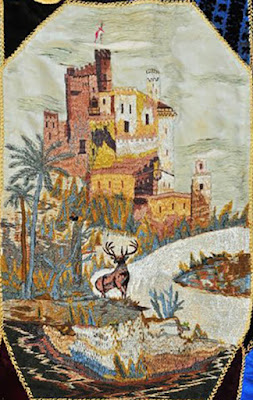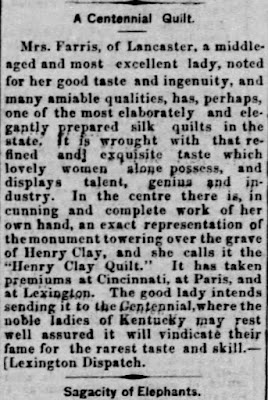Collection of the Kentucky Historical Society
Crazy quilt by Elizabeth Chaney Vass Hoskins Farris (1822-1912)
https://kyhistory.pastperfectonline.com/webobject/E44C4D70-6A97-49B2-85FC-612780314716
Eliza seems to have incorporated several textiles
into her crazy quilt. The center landscape may be a
machine-embroidered tropical landscape
with an elk added.
Several of the birds and florals look very much like
the machine-embroidered silk swatches one
could buy after 1880 or so.
Bluebird satin-stitched by machine to a piece of silk incorporated into
another crazy quilt from the high-point of the style 1882-1900
See a post on these slips or purchased embroideries here:
Eliza Farris was a skilled seamstress, famous for her quilts in her home state. Kentucky fairs made entering and winning prizes worthwhile.
In 1852 30-year-old Eliza Hoskins won $25 for a silk quilt at the state fair. This may be the first of her many prizes over the next decades.
What was $25 worth? This 1849 ad informs us that calico in South Carolina cost 5 cents a yard and wool delaine/combination fabric 12-1/2 cents or more---The cash prize could buy you 500 yards of printed cotton. $25 equaled thousands of dollars worth of goods to us. You can see why Eliza entered many contests.
She won two certificates with two quilts at a local fair
the same year, one certificate for a silk quilt and one for a worsted.
Certificates had no cash prizes.
It wasn't that she needed the money, although even a well-to-do miss would welcome a little pin money. She lived with her parents William and Elizabeth Bright Hoskins who farmed a large acreage near Bryantsville in Garrard County. Her single blessedness and the family's 19 enslaved farm workers and house servants gave her leisure time to make these elaborate show quilts.
The crazy quilt above is the only surviving piece attributed to Eliza. By its style we date it to after 1880 when she was in her sixties, married to James W. Farris, and living on his farm near Lexington, Garrard County. Her show quilts were usually described as silk quilts in the publicity published about her awards. The wool/worsted quilt is an exception.
Story copied in at least three newspapers from
Minneapolis to Wilkes-Barre, winter of 1876.
The display may also have included her "Henry Clay quilt," which featured his tombstone monument, a statue of the Kentucky politician atop an imposing obelisk.
Ashland in Lexington, Kentucky, 1852
After Clay's death the home was torn down and rebuilt.
The silk quilt with an embroidered white center sounds like the 1876 Henry Clay quilt that pictured the monument, the Clay's home Ashland and another small building, maybe his Virginia birthplace.
One wonders why Eliza Hoskins Farris's name was in the papers so much. An article like the rambling account above might have been written by a publicist for the new Governor. But was it written and submitted by Eliza herself, who seems to have been her own very efficient publicity manager? She may not have been in the quiltmaking business for the prize money, but rather the attention.
Aside from her quiltmaking reputation Eliza enjoyed post-Civil-War honors as a "Lady Remembered Kindly by Many East Tennessee Union Soldiers." Her family lived across the road from their Robinson relatives' estate that was commandeered for a Union post at the beginning of the war. When young soldiers caught the measles Eliza (and probably her sisters and sisters-in-law) nursed them.
"The compassionate farm girl," often recalled as “Angel of the Hospital,” was not a girl but 39 years old at the beginning of the war. Camp Dick Robinson was not a hospital but a post that recruited, trained and lodged Union troops moving through Union-held Kentucky. Her reputation as an important Civil War nurse might have been polished to support her pension application.
In 1895 a lengthy feature appeared in the Knoxville Journal describing the Clay quilt, which she promised to give Lancaster neighbor, the recently elected Governor William O. Bradley, when he was elected president. Bradley had championed her failed request for a Civil War pension in Congress. Despite her endorsement he never became president. And we don't know where the promised quilt is today.
One wonders why Eliza Hoskins Farris's name was in the papers so much. An article like the rambling account above might have been written by a publicist for the new Governor. But was it written and submitted by Eliza herself, who seems to have been her own very efficient publicity manager? She may not have been in the quiltmaking business for the prize money, but rather the attention.
Camp Dick Robinson at Hoskins Crossroads
Her reputation as the "Angel of the Camp," continues into the 21st century as in this 2016 book mentioning Camp Dick Robinson.
At a time when most women would have been horrified to see their names in the newspaper, Eliza is featured in dozens and dozens of clippings from 1850 to her death in 1910.
Above an article in the Kansas City Star after her death with this portrait.
Social notes in the Danville paper, 1910.
An interesting woman with a penchant for publicity.
























As a resident of the Commonwealth of Kentucky, I enjoy reading about the quiltmakers from Kentucky! Thank you so much for the history and photos! Kelley Secrest
ReplyDelete